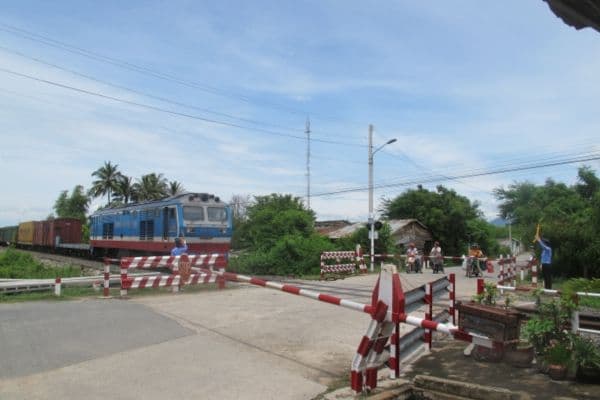Can road traffic participants stop their vehicles at railway crossings? Regulations on railways within the scope of railway crossings?
Are Road Users Allowed to Stop Their Vehicles in Level Crossings?
Pursuant to the provisions of Article 32 Circular 29/2023/TT-BGTVT, the regulations are as follows:
Stopping and Parking in Level Crossings
1. Vehicles are not allowed to turn around, stop, or park within the area between the two "Stop" lines at a level crossing.
2. If a road vehicle breaks down, is involved in an accident, or loses cargo and cannot be moved immediately out of the area between the two "Stop" lines at a level crossing, the driver must find a way to quickly remove the vehicle and cargo from this area.
In case the nearest point of the vehicle or cargo is less than 1.75 meters (m) from the outer edge of the outermost rail, the driver must find a way to signal the train to stop before it reaches the obstruction; simultaneously, by all means, quickly move the vehicle and cargo to a minimum distance of 1.75 meters (m) from the outer edge of the outermost rail. The method to stop the train before the obstruction is stipulated in Annex VI of this Circular.
Thus, based on the above provisions, road users are not allowed to stop their vehicles within the area between the two "Stop" lines at a level crossing according to the regulations.

Are road users allowed to stop their vehicles in level crossings? What are the regulations regarding railways within level crossings? (Image from the internet)
What Are the Regulations Regarding Railways within Level Crossings?
Pursuant to the provisions of Article 7 Circular 29/2023/TT-BGTVT, the regulations on railways within level crossings are as follows:
Technical Requirements:
- The surface structure of the level crossing must include guard rails or other structures to create a gap between the main rail and the guard rail or between the main rail and such structures (hereinafter referred to as track gaps) that meet the following requirements:
+ Guard rails or gap structures must be placed within the scope of the two sides of the road;
+ Gap width:
++ For level crossings on straight tracks or tracks with a radius of 500 meters (m) or more: gap width must be 75 millimeters (mm);
++ For level crossings on tracks with a radius smaller than 500 meters (m): gap width must be 75 millimeters (mm) + 1/2 of the track widening according to the national technical standard for railway operation;
+ Gap depth must be at least 45 millimeters (mm);
+ If the road surface within the railway is asphalt concrete, guard rails must be used to create the track gap; the elevation of the guard rail must be the same as the main rail;
+ If the road surface within the railway is composed of slabs, the edge of the slab adjacent to the main rail must have a special structure to create the track gap;
+ In cases where guard rails are used as stipulated in point a of this clause, both ends of the guard rail are bent inwards into the railway; the length of the bent guard rail section is 500 millimeters (mm), the gap at the bending start point is stipulated in point b of this clause, and the gap at the end point of the rail is 250 millimeters (mm). At the bending start point and the end point of the guard rail, there must be a tight connection with the sleepers;
+ Rail joints are not to be placed within the level crossing range. For wide roads at level crossings, rails must be welded together; if not welded, rails must be juxtaposed to burn the joints;
+ All rail connecting accessories must be complete and tightly connected.
Material Requirements:
- The sleepers within the level crossing range must be reinforced concrete sleepers; iron or wooden sleepers should be limited within the range of existing level crossings; new level crossings must not use iron or wooden sleepers;
- The track bed within the level crossing must be clean, thick enough, and meet the specified standards;
- The materials and supplies used for the level crossing must meet the standards for materials and supplies used for railway construction.
What Must Animal Handlers Do Before Leading Animals Across Unguarded Level Crossings?
Pursuant to the provisions of Article 34 Circular 29/2023/TT-BGTVT, it is stipulated as follows:
Leading Animals Across Level Crossings
1. Before leading a herd of animals across a guarded level crossing, the animal handler must contact the level crossing staff to obtain train schedule information and receive guidance.
2. Before leading a herd of animals across an unguarded level crossing, the animal handler must observe the approaching railway traffic and only lead the herd across when it is safe to do so.
3. The animal handler must lead the herd along the right edge of the road. The animal handler is fully responsible for any accidents that occur due to non-compliance with the traffic rules at the level crossing as stipulated in this Circular.
Thus, based on the above provisions, before leading a herd of animals across an unguarded level crossing, the handler must observe approaching railway traffic and only proceed when it is safe to do so.
*Note: The animal handler must lead the herd along the right edge of the road. The handler is fully responsible for any accidents that occur due to non-compliance with the traffic rules at the level crossing as stipulated.
Circular 29/2023/TT-BGTVT takes effect from December 1, 2023.
LawNet